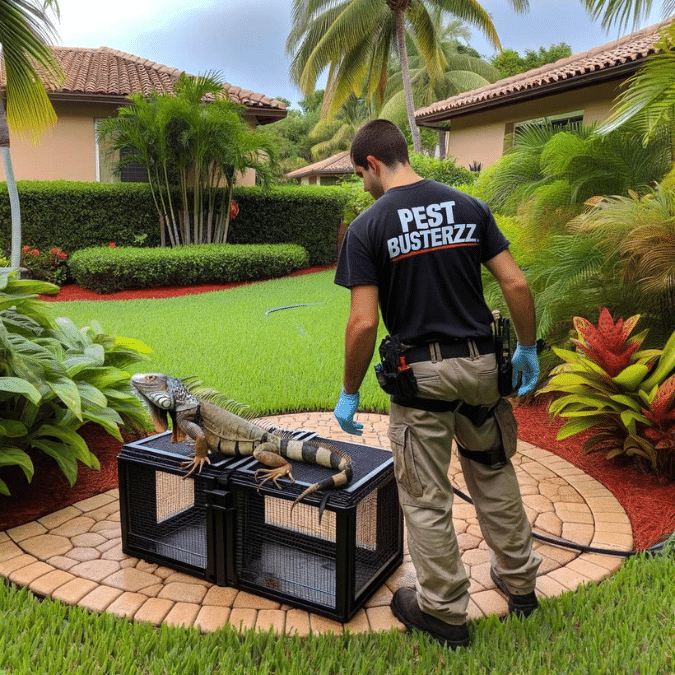
26 Jul How To Get Rid Of Iguanas In Your Backyard
Effective Strategies for a Reptile-Free Backyard
Iguanas are a common sight in South Florida, often basking in the sun or munching on plants in backyards. While they may seem harmless, iguanas can cause damage to landscaping, leave droppings, and even burrow, which can undermine structures. If you’re facing an iguana problem, Pest Busterzz is here to help. Here’s a comprehensive guide to getting rid of iguanas in your backyard.
Understanding Iguanas
Before diving into solutions, it’s essential to understand these reptiles. Iguanas are herbivores, primarily feeding on plants, flowers, and fruits. They are known for their excellent climbing abilities and can often be found in trees or on fences. Iguanas are most active during the day and prefer warm, sunny spots for basking.
Identifying an Iguana Problem
The first step in addressing an iguana issue is recognizing the signs of their presence:
Visible Sightings: Seeing iguanas regularly in your backyard is the most obvious sign.
Plant Damage: Iguanas feed on a variety of plants, so chewed leaves and flowers can indicate their presence.
Droppings: Iguana droppings are large and can be a health hazard, as they may carry salmonella.
Burrows: Iguanas dig burrows for nesting, which can damage lawns and undermine structures.
Effective Solutions for Iguana Control
- Habitat Modification
One of the most effective ways to deter iguanas is by making your backyard less appealing to them. This can include:
Removing Food Sources: Keep your garden and lawn free from fruits and vegetables that iguanas might eat. Consider using iguana-resistant plants in your landscaping.
Eliminating Basking Spots: Remove large rocks, logs, or other objects where iguanas may bask in the sun.
Filling Burrows: If you find iguana burrows, fill them with gravel or sand to discourage further digging.
- Physical Barriers
Creating barriers can prevent iguanas from entering your property:
Fencing: Install a fence that is at least 4 feet high and angled outward at the top to prevent iguanas from climbing over. A smooth, slick surface can also deter them.
Tree Guards: Wrap sheet metal around the trunks of trees to prevent iguanas from climbing.
- Repellents
There are various repellents available that can discourage iguanas from entering your yard:
Commercial Repellents: Look for repellents specifically designed for iguanas, and follow the instructions carefully.
Homemade Repellents: Some people have had success using a mixture of water, garlic, and chili pepper sprayed around the perimeter of their property.
- Trapping
Trapping is a humane way to remove iguanas from your property. It’s essential to check local regulations before trapping, as iguanas are protected in some areas. Pest Busterzz can provide professional trapping services to safely and effectively capture and relocate iguanas.
- Professional Assistance
For severe infestations or if you’re unsure how to proceed, it’s best to seek professional help. Pest Busterzz offers expert iguana control services, including inspections, habitat modification, trapping, and exclusion techniques to keep your backyard iguana-free.
Long-Term Iguana Management
Preventing iguanas from returning is just as important as removing them. Regularly inspect your property for signs of iguanas, maintain barriers, and keep your yard free from food sources. Working with a professional pest control service like Pest Busterzz can provide ongoing monitoring and management to ensure your backyard remains iguana-free.
Conclusion
Iguanas can be a nuisance in South Florida backyards, but with the right strategies, you can effectively control and prevent them. Habitat modification, physical barriers, repellents, and professional assistance are all effective methods for dealing with iguanas. Pest Busterzz is here to help you every step of the way, ensuring your backyard is a safe and enjoyable space for you and your family.


No Comments